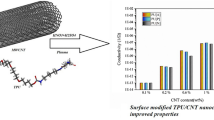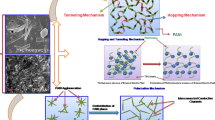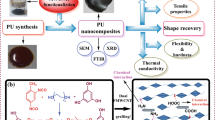Abstract
In this research work, solution dispersion technique was employed for the preparation of segmented poly (azo-urethane)/multi-walled carbon nanotube (SPAU/MWCNT) nanocomposites whereas the polyurethane was obtained using single-step procedure. The carboxylated nanotube-based non-compatiblized SPAU/MWCNT and acid chloride functionalized MWCNT-based compatiblized systems were prepared. Afterwards, the hydroxyl end-terminated polyurethane was grafted to acid chloride functional MWCNT through esterification reaction. The grafting to the carboxylated nanotube was achieved via physical interaction. The FTIR spectra confirmed the covalent bonding between the matrix and side-walls of nanotube. Various nanotube loading levels and surface-modified groups were considered to regulate mechanical, thermal and electrical performance of SPAU/MWCNT. The experimental results showed that a moderate loading-level of 5 wt. % MWCNT produced the maximum tensile strength (63.1 MPa) in compatiblized nanocomposites, while the tensile strength of non-compatiblized SPAU/MWCNT was lower (47.25 MPa). Comparative studies based on scanning and transmission electron microscopy of the chemically bonded samples also revealed the covalent coating character and unique nano-fibriller morphology. The dynamic mechanical analysis of nanocomposites showed segmental rigidity due to covalent linking and sample had Tg of 142–152 °C. Addition of acid chloride functionalized MWCNT also contributed to an improvement in the electrical conductivity (2.01-4.31 S cm−1) relative to SPAU/carboxylated MWCNT 1.27-2.86 S cm−1.












Similar content being viewed by others
References
Zdenko S, Dimitrios T, Konstantinos P, Costas G (2010) Carbon nanotubepolymer composites: chemistry, processing, mechanical and electrical properties. Prog Polym Sci 35:357–401
Nanda GS, Sravendra R, Jae WC, Lin L, Siew HC (2010) Polymer nanocomposites based on functionalized carbon nanotubes. Prog Polym Sci 35:837–867
Lin Y, Zhou B, Fernando SKA, Liu P, Allard LF, Sun YP (2003) Polymeric carbon nanocomposites from carbon nanotubes functionalized with matrix polymer. Macromolecules 36:7199–7204
Liu T, Phang IY, Shen L, Chow SY, Zhang WD (2004) Morphology and mechanical properties of multiwalled carbon nanotubes reinforced nylon-6 composites. Macromolecules 37:7214–7222
Sreekumar TV, Liu T, Min BG, Go H, Kumar S, Hauge RH, Smalley RE (2004) Polyacrylonitrile single-walled carbon nanotube composite fibers. Adv Mater 16:58–61
Brown JM, Anderson DP, Justice RS, Lafdi K, Belfor M, Strong KL, Schaefer DW (2005) Hierarchical morphology of carbon single-walled nanotubes during sonication in an aliphatic diamine. Polymer 46:10854–10865
Kanagaraj S, Varanda FR, Zhiltsova TV, Oliveira MSA, Simoes JAO (2007) Mechanical properties of high density polyethylene/carbon nanotube composites. Comp Sci Technol 67:3071–3077
Grossiord N, Miltner HE, Loos J, Meuldijk J, Van Mele B, Koning CE (2007) On the Crucial role of wetting in the preparation of conductive polystyrene-carbon nanotube composites. Chem Mater 19:3787–3792
Chen J, Hamon MA, Hu H, Chen YS, Rao AM, Eklund PC, Haddon RC (1998) Solution properties of single-walled carbon nanotubes. Science 282:95–98
Sano M, Kamino A, Okamura J, Shinkai S (2001) Self-Organization of PEO-graft-single-walled carbon nanotubes in solutions and langmuir-blodgett films. Langmuir 17:5125–5128
Ying YM, Saini RK, Liang F, Sadana AK, Billups WE (2003) Functionalization of carbon nanotubes by free radicals. Org Lett 5:1471–1473
Georgakilas V, Kordatos K, Prato M, Guldi DM, Holzinger M, Hirsch A (2002) Organic Functionalization of canbon nanotubes. J Am Chem Soc 124:760–761
Ruan SL, Gao P, Yang XG, Yu TX (2003) Toughening High performance ultrahigh molecular weight polyethylene using multi-walled carbon nanotubes. Polymer 44:5643–5654
Jin Z, Pramoda KP, Xu G, Goh SH (2001) Dynamic mechanical behavior of melt-processed multi-walled carbon nanotube/poly (methyl methacrylate) composites. Chem Phys Lett 337:43–47
Gojny FH, Nastalczyk J, Roslaniec Z, Schulte K (2003) Surface modified multi-walled carbon nanotubes in CNT/Epoxy-Composites. Chem Phys Lett 370:820–824
Sahoo NG, Jung YC, Yoo HJ, Cho JW (2006) Effect of functionalized carbon nanotubes on molecular interaction and properties of polyurethane composites. Macromol Chem Phys 207:1773–1780
Sahoo NG, Jung YC, Yoo HJ, Cho JW (2007) Influence of carbon nanotubes and polypyrrole on the thermal, mechanical and electroactive shape-memory properties of polyurethane nanocomposites. Compos Sci Technol 67:1920–1929
Chattopadhyay DK, Dean CW (2009) Thermal stability and flame retardancy of polyurethanes. Prog Polym Sci 34:1068–1133
Marc B, Muhammad YR, Andreas L (2010) Multifunctional shape-memory polymers. Adv Mater 22:3388–3410
Kong H, Gao C, Yan D (2004) Controlled functionalization of multiwalled carbon nanotubes by in situ atom transfer radical polymerization. J Am Chem Soc 126:412–413
Liu I, Huang H, Chang HC, Tsai H, Hsu C, Tsiang RC (2004) Preparing a styrenic polymer composite containing well-dispersed carbon nanotubes: Anionic polymerization of a nanotube-bound p-methylstyrene. Macromolecules 37:283–287
Lin M-F, Thakur VK, Tan EJ, Lee PS (2011) Dopant induced hollow BaTiO3 nanostructures for application in high performance capacitors. J Mater Chem 21:16500–16504
Thakur VK, Tan EJ, Lin M-F, Lee PS (2011) Poly (vinylidene fluoride)-graft-poly (2-hydroxyethyl methacrylate): A novel material for high energy density capacitors. J Mater Chem 21:3751–3759
Lin M-F, Thakur VK, Tan EJ, Lee PS (2011) Surface functionalization of BaTiO3 nanoparticles and improved electrical properties of BaTiO3/polyvinylidene fluoride composite. RSC Advances 1:576–578
Thakur VK, Ding G, Ma J, Lee PS, Lu X (2012) Hybrid Materials and Polymer Electrolytes for Electrochromic Device Applications. Adv Mater 24:4071–4096
Thakur VK, Yan J, Lin M-F, Zhi C, Golberg D, Bando Y, Sim R, Lee PS (2012) Novel polymer nanocomposites from bioinspired green aqueous functionalization of BNNTs. Polym Chem 3:962–969
Hussain S T U.S. (2009) Novel catalyst to manufacture carbon nanotubes and hydrogen gas. PatentUS2009208403
Hussain ST, Abbas F, Kausar A, Khan MR (2012) New polyaniline/polypyrrole/polythiophene and functionalized multi-walled carbon nano-tubes based nanocomposites: Layer by layer in-situ polymerization. High Perform Polym 25:70–78
Kausar A, Hussain ST (2013) Physical and thermal properties of thermoplastic poly (azo-urethane) s: Effect of novel chain extender and hard segment content. High Perform Polym 25:337–347
Sahoo NG, Jung YC, Yoo HJ, Cho JW (2007) Influence of carbon nanotubes and polypyrrole on the thermal, mechanical and electroactive shape-memory properties of polyurethane nanocomposites. Comp Sci Tech 67:1920–1929
Wang T-L, Tseng C-G (2007) Polymeric carbon nanocomposites from multiwalled carbon nanotubes functionalized with segmented polyurethane. J Appl Polym Sci 105:1642–1650
Buffa F, Abraham GA, Grady BP, Resasco D (2007) Effect of nanotube functionalization on the properties of single-walled carbon nanotube/polyurethane composites. J Polym Sci Part B Polym Phys 45:490–501
Chattopadhyay DK, Dean CW (2009) Thermal stability and flame retardancy of polyurethanes. Prog Polym Sci 34:1068–1133
Author information
Authors and Affiliations
Corresponding author
Rights and permissions
About this article
Cite this article
Kausar, A., Siddiq, M. Influence of interface interaction on thermal, mechanical and conducting properties of segmented poly (azo-urethane)/carbon nanotube composites. Int J Plast Technol 18, 203–222 (2014). https://doi.org/10.1007/s12588-014-9079-7
Received:
Accepted:
Published:
Issue Date:
DOI: https://doi.org/10.1007/s12588-014-9079-7




